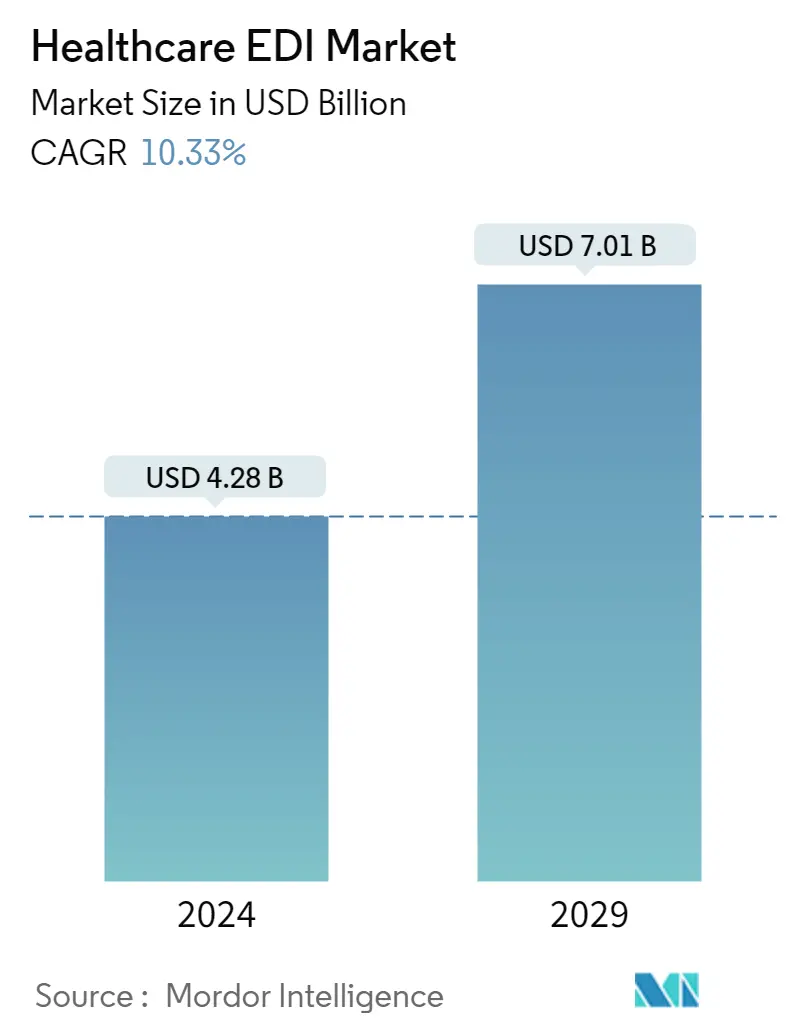Market Size of Healthcare EDI Industry

| Study Period | 2019 - 2029 |
| Market Size (2024) | USD 4.28 Billion |
| Market Size (2029) | USD 7.01 Billion |
| CAGR (2024 - 2029) | 10.33 % |
| Fastest Growing Market | Asia Pacific |
| Largest Market | North America |
Major Players.webp)
*Disclaimer: Major Players sorted in no particular order |
Need a report that reflects how COVID-19 has impacted this market and its growth?
Healthcare EDI Market Analysis
The Healthcare EDI Market size is estimated at USD 4.28 billion in 2024, and is expected to reach USD 7.01 billion by 2029, growing at a CAGR of 10.33% during the forecast period (2024-2029).
The growing number of laws for transaction processes, due to massive volumes of data being generated due to increased incidences of chronic diseases, is one of the primary drivers projected to boost demand for the Healthcare EDI Market. The increased need to properly handle electronic claims and reimbursement transactions is projected to drive up demand for healthcare EDI in the future.
- Healthcare practitioners demand systems and software to manage vast amounts of medical data. Monitoring patient history reports, emergency services records, and prescription data is critical in the healthcare industry. Healthcare EDI solves healthcare employees' obstacles or issues in the payment system. Among the most common applications of healthcare EDI systems are dental and medical patient payment management, insurance and reimbursement data management, and clinical trials and medical data management. The growing awareness and cost-effectiveness of EDI have aided the growth of the Healthcare EDI market.
- The expanding number of EDI providers will propel the Healthcare Electronic Data Interchange industry ahead. Such EDI providers are effectively addressing the industry's issues. EDI providers, for example, manage time-consuming tasks such as communicating with trade partners and clients, troubleshooting and resolving software difficulties. They assume responsibility for handling the EDI requirements imposed by government agencies and ensuring compliance with current laws and regulations.
- Electronic data exchange services/solutions that have been technologically innovated, such as web-based EDI, have improved to handle challenges of secrecy, authentication, and data integrity. Electronic data exchange is now helpful for Business-to-Business (B2B) transactions because of advancements in the American National Standards Institute (ANSI) X12 EDI formatting standard. The rise of Extensible Markup Language (XML) and web-based standards in electronic data interchange is propelling the sector forward.
- Implementing EDI software in healthcare industries with complicated use cases and technologies is difficult. On the other hand, the EDI mapping and development of the EDI maps for the organization for each related trade partner and the development of various EDI maps are problematic for the growth of the Healthcare Electronic Data Interchange market. Healthcare EDIs are implemented largely to save time, yet, communicating with trading partners is generally time-consuming. Additional time-consuming responsibilities include troubleshooting EDI issues and EDI testing. These reasons impede the overall expansion of the Healthcare Electronic Data Interchange market.
- The COVID-19 pandemic hastened digital transformation efforts. The supply chain was one of the most affected areas of industry, with considerable disruption worldwide. It became evident that developing the needed levels of resilience and agility was impossible with so many intricate manual processes. Hospitals worldwide must digitally engage and trade with their partner ecosystems and automate as many procedures as feasible. The pandemic has focused attention on how organizations might achieve this goal at a low cost. Linking to a cloud-based EDI network, such as OpenTextTM Trading GridTM, allows users to quickly and easily connect and trade with suppliers and customers worldwide - all while providing built-in value-added solutions to improve visibility, automate processes, and accelerate business.
